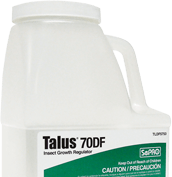Talus® 70DF
Break the Life Cycle


In addition to its phenomenal activity against nuisance insects, some of the best features of Talus Insect Growth Regulator (IGR) include its tenderness to ornamentals, tomatoes and beneficial insects. Talus is effective via contact, ingestion and vapor activity. Talus is also faster acting and has a larger window of application within the target pests’ life cycle compared to other IGRs.
In addition to its primary mode of action, Talus also suppresses egg-laying and causes egg sterilization in infected adults. Even though Talus is classified as an IGR (Insect Growth Regulator), it works fast to eliminate insect pests and save your crops.
Classified as a chitin synthesis inhibitor, Talus disrupts molting by blocking the formation of chitin, the building block of insect exoskeleton. The exoskeleton, the insect's skin and bones, must be absorbed and then re-formed during each successive molt. Without the ability to synthesize chitin, molting is incomplete, resulting in malformed pests that soon die. Talus delivers toxicity to pests via contact, ingestion and vapor activity. There is little or no systemic movement of Talus in plants. But its vapor activity allows Talus to reach leaf undersides where many pest species dwell, and it helps protect new growth. In addition to its primary mode of action, Talus also suppresses egg-laying and causes egg sterility in treated adults through secondary hormonal activity.
SePRO provides high-quality solutions for insect and disease control, as well as plant growth regulation to help you bring healthy, sellable plants and produce to your customers. See how we can help.